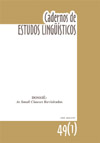Abstract
This paper aims to bring back some central issues concerning Small Clauses, accounted for in the gerativist literature of the 80’s and 90’s, mainly. We intend to clarify these points using examples of Brazilian Portuguese. We also intend to present this as a means to disseminate these debates to make them available to those who are interested in the subject, as well as to point out empiric and teoretic questions that demand some kind of solution and that can be the theme of future research.References
BASÍLICO, D. (2003). The topic of small clauses. Linguistic Inquiry. Vol. 34, no 34. Massachusetts Institute os Tecnology, p. 1-35.
CARDINALETTI, Anna, GUASTI, Maria Teresa. (1995). Small clauses: some controversies and issues of acquisition. In: CARDINALETTI & GUASTI (org.). Syntax and Semantics, 28: small clauses. San Diego, California: Academic Press, p. 1-23.
CARLSON, G. (1977). A unified analysis of the English bare plural. Linguistics and Philosophy, Dordrecht, v. 1, p. 413-457.
CASTILLO, C. (2001). The configuration of ECM structures. Studia Linguistics. Oxford: Blackwell Publishers, p. 113-139.
CHOMSKY, N. (1982). Some concepts and consequences of the theory of government and binding. Cambridge (MA): MIT Press.
FOLTRAN, M. J. (1999). As Construções de Predicação Secundária no Português do Brasil: aspectos sintáticos e semânticos. São Paulo. Tese de Doutorado. Universidade de São Paulo.
FRANCHI, C., NEGRÃO, E. V. e MULLER, A. L. (1998). Um exemplo de análise e de argumentação em Sintaxe. Revista da ANPOLL, v. 5, p. 37-63.
GRIMSHAW (1991) Extended projections. Ms. Brandeis University, Waltham, Mass. HEYCOCK, C. e A. KROCH (1999). Pseudocleft connectedness: implications for the LF Interface Level. Linguistic Inquiry, Vol. 30, no 3. Massachusetts Institute of Technology, p. 365-397.
HORNSTEIN, N. (2001). Move! A Minimalist Theory of Construal. Blackwell Publishers.
KOOPMAN H. & D. SPORTICHE (1991). The position of subjects. Lingua: 211-258.
McNULTY, E. M. (1988). The syntax of adjunct predicates. Michigan: UMI (Dissertation Service).
MIOTO, C., FIGUEIREDO SILVA, M. C. e LOPES, R. E. V. (2004). Novo Manual de Sintaxe. Florianópolis: Insular.
MORO, A. (1995). Small clauses with predicative nominals. In: CARDINALETTI & GUASTI (org.). Syntax and Semantics, 28: small clauses. San Diego, California: Academic Press, p. 109-132.
RAPOSO, E. (1987). Case theory and Infl-to-Comp: The inflected infinitive in European Portuguese. Linguistic Inquiry: 85-109.
RAPOSO, E., URIAGEREKA, J. (1995). Two types of small clauses (toward a syntax of theme/rheme relations). In: CARDINALETTI & GUASTI (org.). Syntax and Semantics, 28: small clauses. San Diego, California: Academic Press, p. 179-206.
ROTHSTEIN, S. (1983). The syntactic forms of predication. Doctoral Dissertation. Massachussetts Institute of Technology.
ROTHSTEIN, S. (1995). Small clauses and copular constructions. In: CARDINALETTI & GUASTI (org.). Syntax and Semantics, 28: small clauses. San Diego, California: Academic Press, p. 27-48.
ROTHSTEIN, S. (2001). Predicates and their subjects. Dordrecht: Kluwer Academic Press.
SCHEIN, B. (1995).Small clauses and predication. In: CARDINALETTI & GUASTI (org.). Syntax and Semantics, 28: small clauses. San Diego, California: Academic Press, p. 49-76.
STARKE, M. (1995). On the format of small clauses. In: CARDINALETTI & GUASTI (org.). Syntax and Semantics, 28: small clauses. San Diego, California: Academic Press, p. 237-269.
STOWELL, T. (1983). Subjects across categories. The Linguistic Review 2. p. 285-312.
WILLIAMS, E. (1983). Against Small Clause. Linguistic Inquiry, 14 (2), 287-308.
The journal CADERNOS DE ESTUDOS LINGUÍSTICOS is granted all the copyright related to the published works. The originals will not be returned. By virtue of being part of this public access journal, the articles are free to use, with their own attributions, in educational and non-commercial applications

